Growing up in the west and specifically in Colorado gave me an opportunity that many don’t have - The ability to get a tag and hunt elk each and every year. As I got older, I extended my range of hunting elk to other western states. I started hunting them with archery gear and muzzleloaders as well. I began scouting for elk early in the summer and watched them grow those huge magnificent velvet antlers. I also started hunting for those pieces of brown gold in the spring, which had been dropped on the winter range, telling me which bulls survived the fall hunting seasons. With nearly forty years of elk hunting experience under my belt and having tagged forty-three branch antlered bulls during this timeframe, I have determined pretty well the gear I must have in my arsenal when I go hunting. I’ve put together a list of items I personally use and won’t leave home without as well as a brief description why. Each and every year, I test a lot of new products and as I determine that one new product is better than an old version, I add it to my arsenal. So, the list of products below is what I use and has been determined to be the very best for my hunting situations and you can be rest assured that they have been proven in the field.
 Carl Zeiss Victory RF 10X54 Binoculars
Carl Zeiss Victory RF 10X54 BinocularsHaving binoculars when you are elk hunting is NOT an option and in my opinion is the primary reason for most of my success. You aren’t going to harvest an elk if you can’t find one and most people hunting elk don’t look far enough away. Although elk are in the deer family, their habits are completely different. Hunters tend to look for deer inside a half a mile and I find most of my elk at well beyond a mile. So, optics are extremely important. I prefer using rangefinding binoculars, which eliminates the need to have two separate pieces of gear - the rangefinder and the binocular. This reduces weight and more importantly, it allows me to have a rangefinder with 10X. When I find an elk, I can also determine how far they are away with my Zeiss Victory’s, since they will get me ranges out to about a mile and a half. Using this range allows me to determine that if I can get over to that next ridge, I’ll be close enough for a shot. These rangefinding binoculars take things to the next level since they give me completely corrected data for my shot. What that means is that it takes into consideration the altitude, barometric pressure, angle, etc. and gives me the exact distance I need to adjust for my shot. They are an extremely solid piece of equipment and the glass is top of the line.
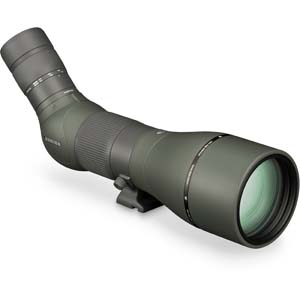 Vortex Razor HD Spotting Scope
Vortex Razor HD Spotting ScopeOnce again, you can’t harvest an elk if you can’t find one. Many times, I find elk at five or six miles and a set of binoculars just isn’t enough to look that far away. This is especially true if you are looking for a bull of a certain size. At these long ranges, you aren’t going to be able to judge a bull with just a set of binoculars and you don’t want to waste the day getting closer if you can do the job from a longer range. With a good spotting scope, you can zoom into 50-60 power and get a much better idea of what you are looking at. Now yes, this is an added weight as well as cost when it comes to hunting. However, the amount of energy you can save by looking through a spotting scope as opposed to hiking two to three miles to get closer is going to leave you with much more in the tank when you do find that bull you want to put your tag on. The Vortez Razor HD spotting scope has proven to be a great optic, one which is also somewhat reasonable in price. It also has an unconditional lifetime warranty, which means that if you kick it off of a rocky bluff while spotting at long ranges and it falls 50 feet, they will replace it no questions asked. Believe me, I know this from experience.
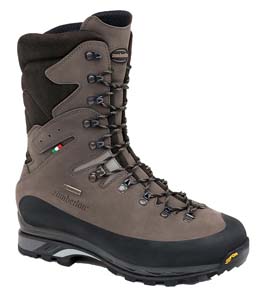 Zamberlan 980 Outfitter GTX Boots
Zamberlan 980 Outfitter GTX BootsBetween scouting, shed hunting and a full hunting season, it isn’t uncommon for me to put on over 1,000 miles a year on a pair of boots. Having a pair of boots that fit me extremely well and can handle the punishment of this kind is essential. If you are going to be a successful elk hunter, you are going to burn up some boot leather over time. When elk are spooked, they can sometimes go 5-10 miles or even more before stopping, so you need to have good boots that fit your feet well and are very broken in. Your feet are your wheels and a pair of boots that either fail on you or rub your feet raw are going to bring your hunt to a screeching halt.

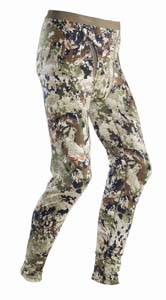 Sitka Gear Subalpine System
Sitka Gear Subalpine SystemBeing able to stay dry and comfortable is essential to staying in the field longer, which gives you more time to be successful. Sitka Gear hit the stage in 2004 and basically took mountaineering gear and developed it more into a hunting platform, which included adding camo. Sitka Gear has numerous different layering systems, specifically designed around each and every style of hunting. Elk hunting during each season has a very specific requirement when you are talking about clothing. During those early August archery hunts, you have got to have an extremely breathable and technical piece of clothing. Getting overheated and sweating excessively is going to cause you to stink and getting close in archery season is a must. Those afternoon rain showers will cool things off and soak you to the bone if you aren’t prepared with a lightweight waterproof shell. When the cold weather kicks in for those late season hunts, you have got to be able to stay warm. This isn’t hard when you take off from the truck and are walking two miles to a lookout point, but it becomes a problem if you are soaked with sweat and now the wind is blowing 20-miles per hour. The Sitka Gear layering system does everything needed to keep you cool, dry or warm depending on the situation. This all equates into being more comfortable and allowing you to be in the field longer, thus giving you more opportunities for success.
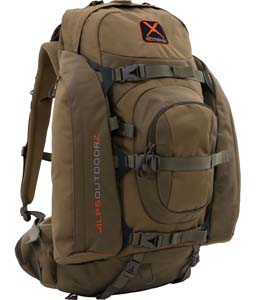 ALPS Traverse Extreme Pack
ALPS Traverse Extreme PackIt isn’t uncommon to leave the truck at four in the morning on an elk hunt and not make it back to the trailhead until well after dark. During this timeframe, you are going to need everything for a full day of hunting as well as all the required items should you be fortunate enough to put your tag on an elk. This means you are going to need a good, comfortable pack that can hold all of these items as well as help you get some of your animal out. This pack has taken care of my needs for the past couple of years. Its 2,900 cubic inches gives me plenty of room for a spotting scope, tripod, clothing, stove, food and water bladder, as well as everything in my “Kill Bag” which comes out when the animal hits the dirt, which includes knives, a saw, extra blades, headlamps, batteries, a small tarp, rope and game bags. This pack also has a meat shelf which helps me get a good load of meat out on my first haul. The shoulder straps are wider than most, which really helps when I get this pack to a hundred pounds. Traverse Extreme has handled these types of loads on numerous occasions for me and has never failed. You are going to require a pack for elk hunting and this is truly a great pack.
 Native by Carlton Elk Calls
Native by Carlton Elk CallsElk are extremely vocal animals and they are the reason most of us go to the woods every September. This being said, they are very susceptible to being called. This isn’t just in September either. I’ve had bulls answer me as early as June and as late as December. In fact, I’m pretty sure you could get a response from some bulls, year around. Elk calls, to me, are like shoes to
 my wife, I can never have enough. I’ve had instances where I have gone through nearly every call in my pocket, the big bull finally responding to the last one I pull out. So, you need an abundance of calls and you need to know how to use them. I personally like the Native by Carlton Calls. Wayne Carlton was my idol as a child and he single handedly taught me how to call elk with all of his different videos. His son, Marc, was making diaphragm calls at their dining room table most of his life while being critiqued by the master. I know the calls that come out of their production line are built for elk hunters, by elk hunters. P.S. The green weenie is a small, green, open reed mouth call that has been working wonders for me for years, but all of their calls are in my arsenal.
my wife, I can never have enough. I’ve had instances where I have gone through nearly every call in my pocket, the big bull finally responding to the last one I pull out. So, you need an abundance of calls and you need to know how to use them. I personally like the Native by Carlton Calls. Wayne Carlton was my idol as a child and he single handedly taught me how to call elk with all of his different videos. His son, Marc, was making diaphragm calls at their dining room table most of his life while being critiqued by the master. I know the calls that come out of their production line are built for elk hunters, by elk hunters. P.S. The green weenie is a small, green, open reed mouth call that has been working wonders for me for years, but all of their calls are in my arsenal.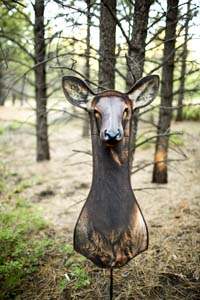 Elk Decoys
Elk DecoysWhen you have gotten a bulls’ attention with your call and he has decided to come in, he is going to be looking for the elk that made that sound. I started using elk decoys about ten years ago and the results are worth the added weight and bulk that go along with carrying a decoy. This is especially true when archery hunting with a buddy. The minute the elks lays his eyes on that decoy, you will see his body language change. He will usually go from a cautious search to a posturing mode, which puts some of those wary senses at ease. I’ve used numerous models of the Montana Decoy and have seen great results. Two years ago, the Butthead full face decoy was launched from Native by Carlton. By putting this decoy on a walking staff, it serves two purposes - it makes a good walking stick and t it is always in your hand. If you walk into a herd of elk in the timber, it isn’t uncommon to have them look at this decoy as your turn it from side-to-side and then go back to feeding. This decoy is with me the entire month of December.
 GPS with Hunt On X Hunt Software
GPS with Hunt On X Hunt SoftwareHaving a GPS and knowing how to use it is key to getting back to the trailhead each and every time. I don’t care how much of an experienced woodsman you are, if you are in new country and it gets dark or a fog bank rolls in, you are likely to have problems getting back to your truck. Whenever I get out of my truck or set up camp, I mark a waypoint on my GPS for future reference. Since I usually hunt in a group, we like to use the Rino versions made by Garmin because they have a 2-way radio built-in and I can see where my buddies are on the map whenever they key the radio. The mapping software on these GPS units will allow you to see the terrain and maneuver in an area without knowing the land in advance. The Hunt On X software is a chip that shows the type of land you are hunting on. Are you on national forest service land, BLM or possibly private? When you hunt in an area that has a good combination of all of the above and you have a bull hung up on the other side of a fence, you can now see if that is a grazing fence or private property and whether you can go after him or not. This combination is amazing when you know how it all works and has allowed me to harvest numerous bulls.
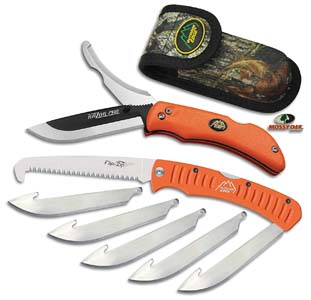 Outdoor Edge Knives
Outdoor Edge KnivesOnce you have had the good fortune of connecting on an animal, it’s time to turn that trophy into quality tablefare. Breaking down a big, mature bull elk is a formidable task if you don’t have some good knives. Outdoor Edge knives makes just about every kind of knife you can imagine and they are extremely durable and affordable. Since I’m not a genius at sharpening knives, I like to use a replaceable blade knife which allows me to dispose of an old blade and replace it with a surgically sharp, fresh one, whenever I need it. The Razor Pro set is exactly what I take in my “Kill Bag” every year. It is the Razor Pro replaceable blade knife with a gutting blade attached, which allows me to cut under the skin without puncturing the intestines. It also keeps my surgical blade sharp much longer. I always take a half a dozen replacement blades with me, which is more than enough to break down several bull elk. The Razor Pro set also has a small folding saw, which is ideal for cutting down small bushes to help get great photos. A large bull elk isn’t going to be moved very far by a couple of guys, so you need to take photos where they fall and you often have to cut down a bunch to get good photos. Outdoor Edge also makes a larger folding saw which is in my kill bag as well.
 Game Bags
Game BagsTaking good care of your meat is the key to having enjoyable and tasty meals of elk for the rest of the year. Getting that hide off of the elk and getting those large quarters of meat cooled down as quickly as possible is essential. I carry a small tarp or a, .2 Mil painters drop cloth, in my “Kill Bag” to help with keeping this process as clean as possible. Once you have quartered up a bull and
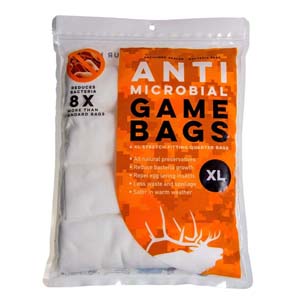 have them out on the tarp, you are going to need to get them into a game bag to help avoid the flies from getting on them. Fly larva is a major problem for your meat as well as your cape and can ruin it all. I like to put my skinned quarters into game bags as they come off of the animals. For years, I have used the Caribou Gear game bags. They are extremely lightweight, washable and reusable and since they are a bit on the pricey side, you want all of the above. However, last season we tested a new product on the market from Koola Buck - presoaked antimicrobial bags. They come in a vacuum sealed pouch with all the pretreated bags you need to haul an elk, deer, moose, etc. During the hot months when the blow flies are the worst, a fly will not stay on the quarters within this bag. A great product and now always in my pack for those days when I’m successful.
have them out on the tarp, you are going to need to get them into a game bag to help avoid the flies from getting on them. Fly larva is a major problem for your meat as well as your cape and can ruin it all. I like to put my skinned quarters into game bags as they come off of the animals. For years, I have used the Caribou Gear game bags. They are extremely lightweight, washable and reusable and since they are a bit on the pricey side, you want all of the above. However, last season we tested a new product on the market from Koola Buck - presoaked antimicrobial bags. They come in a vacuum sealed pouch with all the pretreated bags you need to haul an elk, deer, moose, etc. During the hot months when the blow flies are the worst, a fly will not stay on the quarters within this bag. A great product and now always in my pack for those days when I’m successful.All of the items I’ve discussed have been fleshed out over thousands of days in the field. Whenever I find a new product that is an improvement over something in the past, I always replace the old one. I’m constantly testing products as well as myself to become the best steward of the land and the animals I harvest. I hope you find this information helpful and that it will help you avoid some of the wasted time, trials, and errors for you that I’ve endured. Best of luck this fall.

